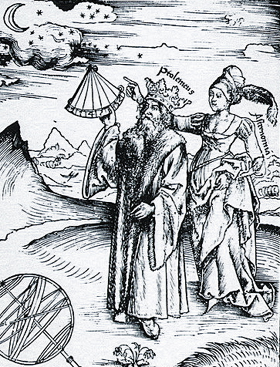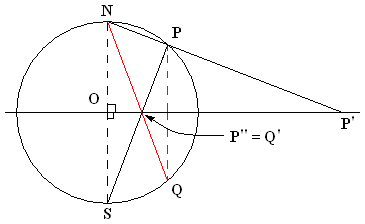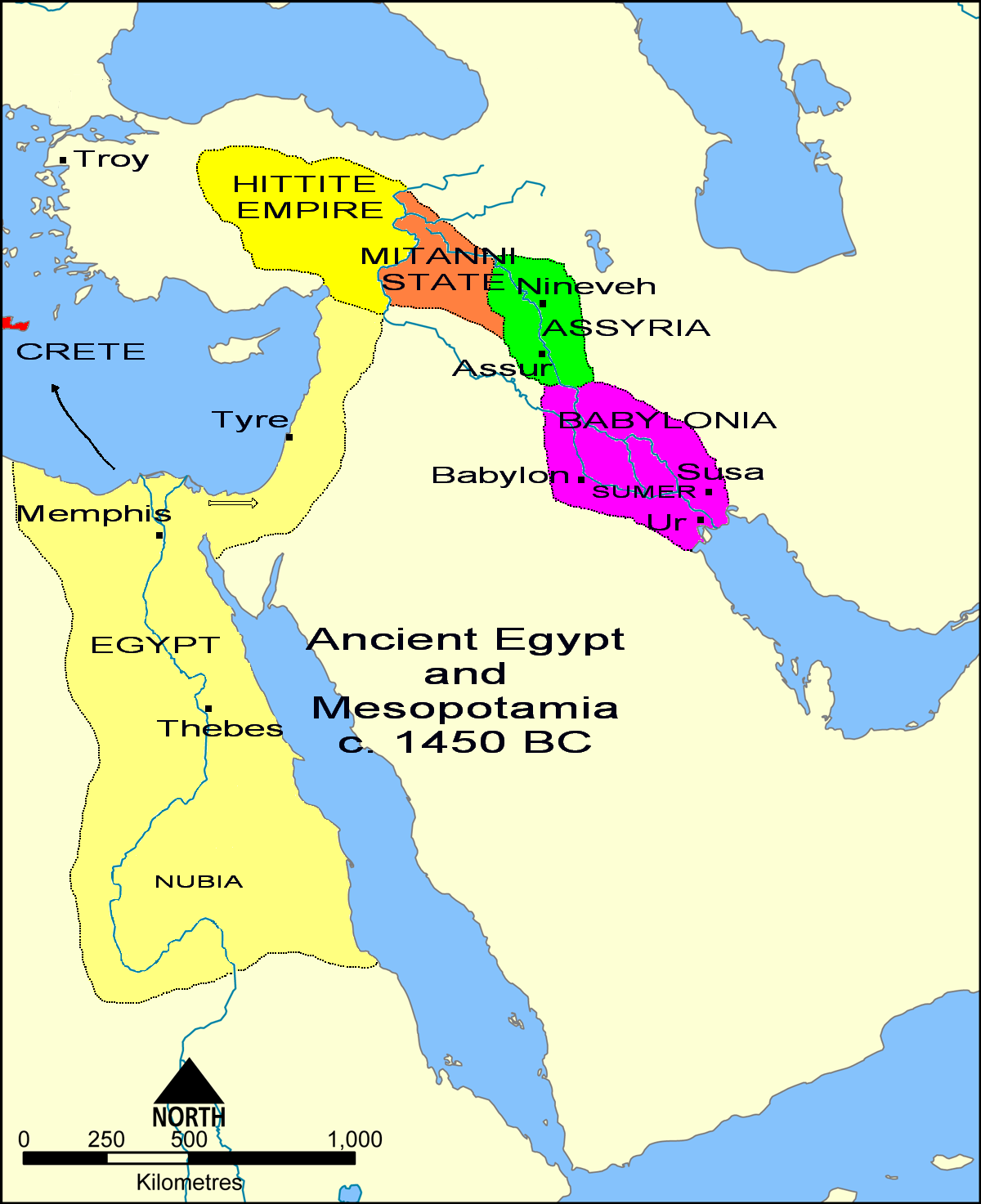|
Planisphaerium
The ''Planisphaerium'' is a work by Ptolemy. The title can be translated as "celestial plane" or "star chart". In this work Ptolemy explored the mathematics of mapping figures inscribed in the celestial sphere onto a plane by what is now known as stereographic projection. This method of projection preserves the properties of circles. Publication Originally written in Ancient Greek, ''Planisphaerium'' was one of many scientific works which survived from antiquity in Arabic translation. One reason why ''Planisphaerium'' attracted interest was that stereographic projection was the mathematical basis of the plane astrolabe, an instrument which was widely used in the medieval Islamic world. The Suda lists a work of Ptolemy titled ''Simplification of the Sphere'' () which is presumed to be ''Planisphaerium''. In 1143 the work was translated from Arabic into Latin by Herman of Carinthia, who also translated commentaries by Maslamah Ibn Ahmad al-Majriti. The oldest known translati ... [...More Info...] [...Related Items...] OR: [Wikipedia] [Google] [Baidu] |
Ptolemy 16century
Claudius Ptolemy (; , ; ; – 160s/170s AD) was a Greco-Roman mathematician, astronomer, astrologer, geographer, and music theorist who wrote about a dozen scientific treatises, three of which were important to later Byzantine, Islamic, and Western European science. The first was his astronomical treatise now known as the ''Almagest'', originally entitled ' (, ', ). The second is the ''Geography'', which is a thorough discussion on maps and the geographic knowledge of the Greco-Roman world. The third is the astrological treatise in which he attempted to adapt horoscopic astrology to the Aristotelian natural philosophy of his day. This is sometimes known as the ' (, 'On the Effects') but more commonly known as the ' (from the Koine Greek meaning 'four books'; ). The Catholic Church promoted his work, which included the only mathematically sound geocentric model of the Solar System, and unlike most Greek mathematicians, Ptolemy's writings (foremost the ''Almagest'') never ceas ... [...More Info...] [...Related Items...] OR: [Wikipedia] [Google] [Baidu] |
Maslamah Ibn Ahmad Al-Majriti
Abu al-Qasim Maslama ibn Ahmad al-Majriti (: c. 950–1007), known in Latin as , was a Muslim Arab astronomer, alchemist, mathematician, economist and scholar in al-Andalus, active during the reign of Al-Hakam II. His full name is Abu 'l-Qāsim Maslama ibn Aḥmad al-Faraḍī al-Ḥāsib al-Maj̲rīṭī al-Qurṭubī al-Andalusī. Achievements Al-Majrīṭī took part in the translation of Ptolemy's '' Planisphaerium'', improved existing translations of the ''Almagest'', introduced and improved the astronomical tables of Muhammad ibn Musa al-Khwarizmi, aided historians by working out tables to convert Persian dates to Hijri years, and introduced the techniques of surveying and triangulation. According to Said al-Andalusi, he was the best mathematician and astronomer of his time in al-Andalus. He also introduced new surveying methods by working closely with his colleague ibn al-Saffar. He also wrote a book on taxation and the economy of al-Andalus. He edited and made chang ... [...More Info...] [...Related Items...] OR: [Wikipedia] [Google] [Baidu] |
Stereographic Projection
In mathematics, a stereographic projection is a perspective transform, perspective projection of the sphere, through a specific point (geometry), point on the sphere (the ''pole'' or ''center of projection''), onto a plane (geometry), plane (the ''projection plane'') perpendicular to the diameter through the point. It is a smooth function, smooth, bijection, bijective function (mathematics), function from the entire sphere except the center of projection to the entire plane. It maps circle of a sphere, circles on the sphere to generalised circle, circles or lines on the plane, and is conformal map, conformal, meaning that it preserves angles at which curves meet and thus Local property, locally approximately preserves similarity (geometry), shapes. It is neither isometry, isometric (distance preserving) nor Equiareal map, equiareal (area preserving). The stereographic projection gives a way to representation (mathematics), represent a sphere by a plane. The metric tensor, metric ... [...More Info...] [...Related Items...] OR: [Wikipedia] [Google] [Baidu] |
Herman Of Carinthia
Herman of Carinthia (1105/1110 – after 1154), also called Hermanus Dalmata or Sclavus Dalmata, Secundus, by his own words born in the "heart of Istria", was a philosopher, astronomer, astrologer, mathematician and translator of Arabic works into Latin. Alongside Adelard of Bath, John of Seville, Gerard of Cremona and Plato of Tivoli, Herman is the most important translator of Arabic astronomical works in 12th century. The influence of his translations on the development of medieval European astronomy was especially large. Name Herman (also spelled Hermann) is known by several bynames in English and Latin referring to his land of origin or his ethnicity: Hermann of Carinthia (''Hermannus de Carinthia''); Hermann of Dalmatia or Hermann the Dalmatian (''Hermannus Dalmata''; ; .); or Hermann the Slav (''Hermannus Sclavus''). Herman always refers to his homeland as Carinthia or Istria. His own preferred nickname was ''Hermannus Secundus'', that is, the "second Hermann", by way of wh ... [...More Info...] [...Related Items...] OR: [Wikipedia] [Google] [Baidu] |
Ancient Greek Mathematical Works
Ancient history is a time period from the beginning of writing and recorded human history through late antiquity. The span of recorded history is roughly 5,000 years, beginning with the development of Sumerian cuneiform script. Ancient history covers all continents inhabited by humans in the period 3000 BCAD 500, ending with the expansion of Islam in late antiquity. The three-age system periodises ancient history into the Stone Age, the Bronze Age, and the Iron Age, with recorded history generally considered to begin with the Bronze Age. The start and end of the three ages vary between world regions. In many regions the Bronze Age is generally considered to begin a few centuries prior to 3000 BC, while the end of the Iron Age varies from the early first millennium BC in some regions to the late first millennium AD in others. During the time period of ancient history, the world population was exponentially increasing due to the Neolithic Revolution, which was in full prog ... [...More Info...] [...Related Items...] OR: [Wikipedia] [Google] [Baidu] |
Paulus Manutius
Paulus Manutius (; ; 12 June 15126 April 1574) was a Venetian printer with a Renaissance Humanism, humanist education, the third son of the famous printer Aldus Manutius and his wife Maria Torresano. Life As a young man, Paulus Manutius moved to Venice to get an education and was well received by his father's old friends Pietro Bembo, Ramberto, and Egnatio. During Paulus' education his grandfather, Andrea Torresani and two uncles, Frederick and Francesco, carried on the Aldine Press. Andrea Torresani died in October 1528 which brought disputes between Paulus and his uncles that halted the work of the press for four years. In 1533 Paulus assumed direction of his father's business. In that first year alone, the press issued eleven titles. From 1536 to 1539, Paulus was involved in a lawsuit against his uncles in an effort to reclaim his father's italic type. In 1539, Paulus won. Paulus was a passionate Ciceronian, and perhaps his chief contributions to scholarship are the corrected ... [...More Info...] [...Related Items...] OR: [Wikipedia] [Google] [Baidu] |
Planisphere
In astronomy, a planisphere () is a star chart analog computing instrument in the form of two adjustable disks that rotate on a common pivot. It can be adjusted to display the visible stars for any time and date. It is an instrument to assist in learning how to recognize stars and constellations. The astrolabe, an instrument that has its origins in Hellenistic astronomy, is a predecessor of the modern planisphere. The term ''planisphere'' contrasts with '' armillary sphere'', where the celestial sphere is represented by a three-dimensional framework of rings. Description A planisphere consists of a circular star chart attached at its center to an opaque circular overlay that has a clear window or hole so that only a portion of the sky map will be visible in the window or hole area at any given time. The chart and overlay are mounted so that they are free to rotate about a common axis. The star chart contains the brightest stars, constellations and (possibly) deep-sky objects ... [...More Info...] [...Related Items...] OR: [Wikipedia] [Google] [Baidu] |
Baghdad
Baghdad ( or ; , ) is the capital and List of largest cities of Iraq, largest city of Iraq, located along the Tigris in the central part of the country. With a population exceeding 7 million, it ranks among the List of largest cities in the Arab world, most populous cities in the Middle East and Arab world and forms 22% of the Demographics of Iraq, country's population. Spanning an area of approximately , Baghdad is the capital of its Baghdad Governorate, governorate and serves as Iraq's political, economic, and cultural hub. Founded in 762 AD by Al-Mansur, Baghdad was the capital of the Abbasid Caliphate and became its most notable development project. The city evolved into a cultural and intellectual center of the Muslim world. This, in addition to housing several key academic institutions, including the House of Wisdom, as well as a multi-ethnic and multi-religious environment, garnered it a worldwide reputation as the "Center of Learning". For much of the Abbasid era, duri ... [...More Info...] [...Related Items...] OR: [Wikipedia] [Google] [Baidu] |
Graeco-Arabic Translation Movement
The Graeco-Arabic translation movement was a large, well-funded, and sustained effort responsible for translating a significant volume of secular Greek texts into Arabic. The translation movement took place in Baghdad from the mid-eighth century to the late tenth century. While the movement translated from many languages into Arabic, including Pahlavi, Sanskrit, Syriac, and Greek, it is often referred to as the Graeco-Arabic translation movement because it was predominantly focused on translating the works of Hellenistic scholars and other secular Greek texts into Arabic. Pre-Abbasid developments Pre-Islamic developments The ninth king of the Sasanian Empire, Shapur II, established the Academy of Gondishapur, which was to be a medical center, a library, as well as a college where various subjects like anatomy, theology, medicine, and philosophy would be studied. Later, Khosrow I established an observatory that could offer studies in dentistry, architecture, agriculture an ... [...More Info...] [...Related Items...] OR: [Wikipedia] [Google] [Baidu] |
Suda
The ''Suda'' or ''Souda'' (; ; ) is a large 10th-century Byzantine Empire, Byzantine encyclopedia of the History of the Mediterranean region, ancient Mediterranean world, formerly attributed to an author called Soudas () or Souidas (). It is an encyclopedic lexicon, written in Medieval Greek, Greek, with 30,000 entries, many drawing from ancient sources that have since been lost, and often derived from Christianity in the Middle Ages, medieval Christian compilers. Title The exact spelling of the title is disputed. The transmitted title (''paradosis'') is "Suida", which is also attested in Eustathius of Thessalonica, Eustathius' commentary on Homer's epic poems; several conjectures have been made, both defending it and trying to correct it in "Suda". * Paul Maas (classical scholar), Paul Maas advocated for the spelling, connecting it to the Latin verb , the second-person singular imperative of , "to sweat". * Franz Dölger also defended , tracing its origins back to Byzantine mi ... [...More Info...] [...Related Items...] OR: [Wikipedia] [Google] [Baidu] |








